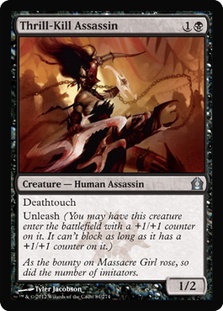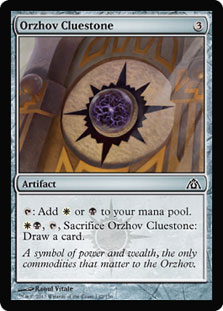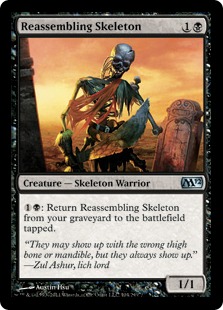It’s new set season, which means it’s a cube designer’s favorite time—time to update our cubes. In previous articles, I’ve talked about how to adopt the idea of Kaizen to approach a cube by striving for continuous improvement and how to temper initial impressions of cards for Cube. I’ve always thought that one of the hardest and most fun parts of cube design is how to craft an environment out of the cards that are in your cube. In this article, I’ll talk about the some methods to make good cube changes.
In the beginning when the idea of a cube was more esoteric, people thought of a cube merely as a set of the greatest cards of all time and that if the collective hive mind deemed that a card was no longer as good as a card that it was replaced by in a new set, it wouldn’t have a chance to return. However, we’ve learned that cube design isn’t solely about deciding what cards are the best.
Although objective power level is certainly amongst one of the more important parts of cube design, it’s also about sculpting your cube for archetype balance and ensuring that all strategies have a fighting chance of doing well. I won’t be talking about how to use initial impressions of cards for cube and how to evaluate them because I’ve discussed that in a previous article; instead, I’ll talk more about how to sculpt your cube using changes.
One of the pitfalls that I sometimes see is when people only consider new cards when making updates for their cube, typically only when a new set comes out, which the equivalent of keeping up with the Joneses. This is not optimal because it gives a myopic point of view where the designer only considers new cards and making changes for similar cards, like cutting a two-mana white creature for another one when a good one gets printed such as Thalia, Guardian of Thraben for Knight of Meadowgrain.
Of course, I’m not saying that making upgrades is bad; replacing Knight of Meadowgrain with Thalia is an upgrade that increases the power level of cards in your cube. Making changes in accordance to new sets is a good thing. It’s a natural thing—we naturally want to compare similar cards since they’re a convenient point of reference for new information and want to replace the card with another one of it fulfills that specific role better. However, these aren’t the only cards that we should consider.
Think of when Torch Fiend got printed in Dark Ascension. I saw cubes replace Torch Fiend with Hearth Kami, and while Torch Fiend was better than Hearth Kami, sometimes this change was made hastily because there were other cards that may have been better to look for something that may have been worse even if it was in a very different section of a cube, like a finisher or a burn spell. Granted, Hearth Kami isn’t in many cubes nowadays, but that’s mostly because we’ve gotten a ton of good red two-drops like Lightning Mauler, Ash Zealot, and Gore-House Chainwalker to push it out. But the lesson is that there may be better replacements even if an "easy upgrade" is there because the card that is getting pushed out may still be contributing positively to your cube.
Instead of finding cube set updates to merely be a time to keep up with sets, I’ve found that cube updates are best approached with a combination of reflection on your cube’s environment and overall analysis rather than looking at individual cards that may not be cutting it anymore and considering cards other than cards from a new set. Although a cube is a cohesive whole, each section is competing against each other—not only amongst the individual colors but the color pairs—and you want to make sure that your white decks aren’t lagging behind the other colors and etc.
As a cube designer who is sculpting an environment, it’s handy to have your cube laid out by section so that you can carefully analyze each section, especially in terms of mana costs, because essentially each section in a cube is competing with each other—at least the five main colors. This is part of why having something like a spreadsheet or an online list is useful—because it helps you to analyze the mana curves and general support for your cube—but if you don’t have that laying it out by color and then mana curve is an essential step to know what’s going on with each of the sections. Typically, it’s the first thing that I do when making changes.
When looking at cards in your cube when making changes, especially when considering making room for newer cards, it’s key to reflect on how each card has been performing in an objective manner in, to note what it’s contributing to your cube environment, and, most importantly, how well it’s doing that. Think of what each card is doing in your cube because each card in your cube should be a mission statement archetype(s) that it supports and how well it’s living up to that promise. Carefully examine those roles and ask yourself questions; not just "is it good enough?" but more detailed questions. For example, when looking at a card like Thrill-Kill Assassin:
Is Thrill-Kill Assassin helping your cube’s black aggressive decks? How often do you find that it’s maindecked versus sideboarded? How early/late does it end up being taken, and how highly is it valued? Most importantly, how much of a positive impact is it making for your black aggressive decks? Are people playing Thrill-Kill Assassin in more slow black decks like U/B control, Grixis, and Jund rather than in decks like black aggro? If so, how well is it performing?
By asking yourself questions, you find out if other cards may be able to contribute better and to make black a better overall color. Justin Parnell talked about sculpting the black section in his cube. It wasn’t that any of the cards that ended up being cut/put in were necessarily bad; he was looking at how to strengthen black overall by adjusting archetypes even if the cards don’t directly compare in their roles. After all, when making decks we typically try to not put "bad" cards in them, but even a deck comprised of powerful cards can perform badly based on context, support, and the environment. In this way, a cube is very similar.
This isn’t to say that you shouldn’t make comparisons between cards in your cube and cards that you are considering putting in because, after all, they’re competition and may compete in pick orders or deck construction. For example, Thrill-Kill Assassin will compete with cards like Dauthi Horror, and those cards will compete with cards like Blood Scrivener.
This is especially true when making changes for cards with limited slots in a cube—think of cards like big blue finishers such as Consecrated Sphinx because even though blue is mainly a control color, it doesn’t tend to top out with a ton of dragons as they only require a few. So having a disproportionally high number of them tends to be unnecessary, but it’s especially true for colors that are adept at both aggro and control like black and white. In these role-fillers, the numbers for these cards tend to stay pretty static.
With those kinds of cards, making straight-up swaps tend to happen more often. Think of the newly spoiled Aetherling. Even though it acts different from cards like Frost Titan, Consecrated Sphinx, and Sphinx of Jwar Isle, it essentially fits the role of a big blue finisher for control decks, and you want to be sure not to overload on those kinds of cards.
When the M11 Titan cycle was printed, people were unsure about whether something like Sun Titan is better than Yosei, the Morning Star (as it turns out, it is). But even then, people were unsure if they should have Sun Titan, Yosei, both, or if they should cut out something else like Eternal Dragon even though all three cards have vastly different talking points and how many a cube designer wants to have is something that can be tinkered with.
A card can be good power-level wise (let’s be honest, they all should be), but it may not necessarily right for your cube’s balance and archetype support.
For example, consider the Cluestones that are coming in Dragon’s Maze.
For most rare cubes, these mana fixers won’t make the grade due to being objectively weaker than other options. However, when considering them for other formats like Peasant and Pauper (uncommon/common and common) cubes, we have some other options, which is useful to think about when considering putting other cards in our cubes.
The first factor is direct competition (Signets / Prismatic Lens / Pristine Talisman for Pauper whereas uncommons bring things like Talismans and Keyrunes), but other things are good to consider such as what they will contribute to the format. The Cluestones tend to lean towards midrange and control strategies, and placing them in something like a Pauper cube may have the cube designer ask if they feel that the additional mana fixer(s) will contribute positively to the format.
If you use all ten Cluestones, will watering down the aggressive pool be a detriment to the environment? If using only certain ones like Azorius Cluestone and Dimir Cluestone in a guild section, would they be better for those decks than their competition like Soul Manipulation? Do the limited mana fixing options in the format make it so that these are a welcome addition or are they unnecessary?
Don’t be scared to make cuts and changes for cards that aren’t directly comparable or to change your overall mana curves if when analyzing your cube’s metagame that your meta could use a shift or if your cube could handle an archetype shift like the Magic Online Cube kicking Cruel Ultimatum out for Rakdos Cackler. Even though the cards are nothing alike, this is an example of a good type of change. Even though the cards are in the same section, they aren’t easy to compare directly because they perform very different tasks, but the change was an upgrade. The black section in particular in the Gatecrash update got a lot of changes with new cards to that cube like Undead Gladiator.
By looking at the individual sections holistically and analyzing each card’s specific role and how the archetypes work in your cube, you can also do things like adjust how they work against other decks. Typically this is done in the form of how decks deal with the plans of other decks like answers to artifacts/enchantments. It’s hard to quantify exactly how many are needed/wanted, especially with ones coming out like Leonin Relic-Warder, but like I discussed when looking at how cards perform in your cube, you can also observe and ask your drafters if certain answers are needed (of course, don’t go overboard and add bad cards like Creeping Corrosion because of artifact decks).
You can also tinker with your cube by bringing cards back based on if a card may have better support than it did in the past (which is why I don’t tend to outright reject cards for cube, as a card that may not have had apt support may now). Flickerwisp was a card that I had in my cube some time ago that I took out because I felt that the other cards were better, but since cubes received many good creatures with ETB triggers, stronger aggressive support, and planeswalkers to reset, it made the grade over cards that it made the grade over before like Paladin En-Vec.
It’s difficult to say whether Paladin En-Vec is objectively more powerful than Flickerwisp since those cards have different strengths and weaknesses even if they share the same mana cost (I’d give the objective power nod to Flickerwisp), but even still I feel that Flickerwisp has had a more positive impact for my white aggressive decks and my white cube section than Paladin.
This creation of synergies part considers how a section works cohesive whole. Even if a card like Flickerwisp may be or may not be objectively than the other, another good example is the recent trend to use black cards that have symmetrical disruption and ways to break it by way of cards like Reassembling Skeleton.
Objectively, a card like Reassembling Skeleton doesn’t seem like a great cube candidate. If you outsource evaluation to other formats, the card never made much of an impact in Standard, and it was a nice draft pick but nothing earth shattering. However, the interactions between it and other cards like Smallpox, Pox, Death Cloud, Liliana of the Veil, and others show what it brings as a whole to the symmetrical disruption and recursion strategies, which in cubes with support for it make it work well in those strategies. Thinking in terms of the "mission statement" for individual cube cards, it promises to work well with those strategies, and in cubes that support it, it does even if it looks like a rather innocuous card (and may very well be in cubes that don’t explicitly support it).
Lastly, don’t be afraid to make changes to the foundations of your cube like the size or your sections. Recently, I decided to test the multicolor section by trimming one of each two-color multicolor card to see how the format changed; I found that the loss of the powerful fourth multicolor cards (like Obzedat, Ghost Council) was a detriment to the environment. I also tried adding ten additional artifacts in another iteration of changes and found that enough of the artifacts weren’t up to the grade. It felt like I was adding weak cards, which inspired me to cut a few cards from the color sections of my cube. Not being afraid to step outside of the traditional boundaries of my cube size helped me to evaluate the cards in my cube and my cube sections in a way that I had not before.
I hope that this article has given you some new insights into making adjustments to your cube and how to utilize it, not just as a way to introduce new cards to your cube but to sculpt it as a well-balanced and fun environment to draft.
May all of your opening packs contain Sol Rings!
@UsmanTheRad on Twitter
My blog featuring my cube lists: http://idratherbecubing.wordpress.com
Cube podcast that Anthony Avitollo and I co-host: The Third Power




